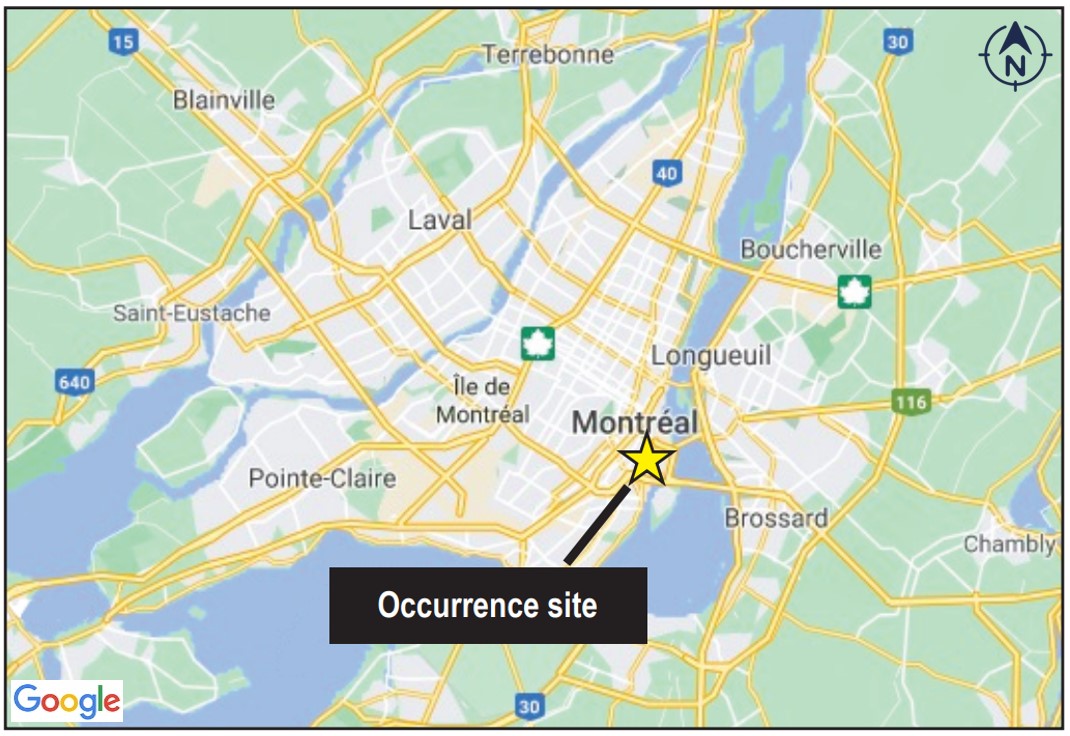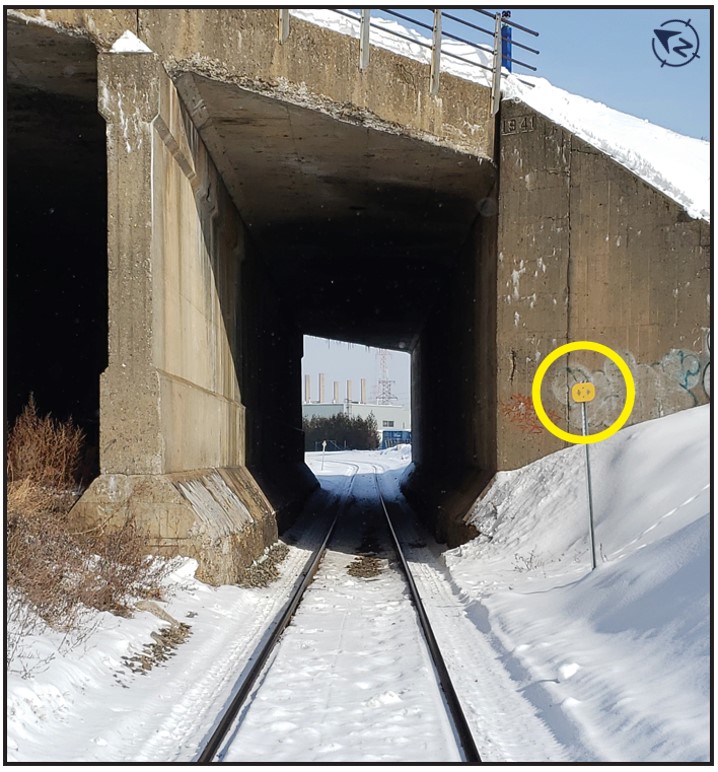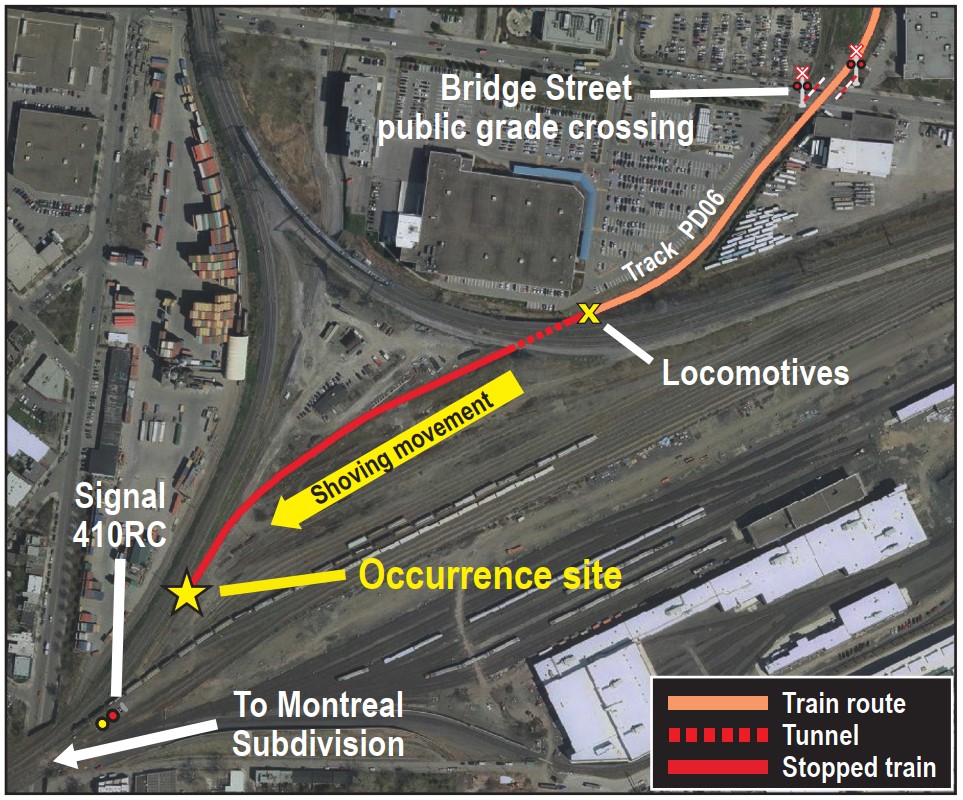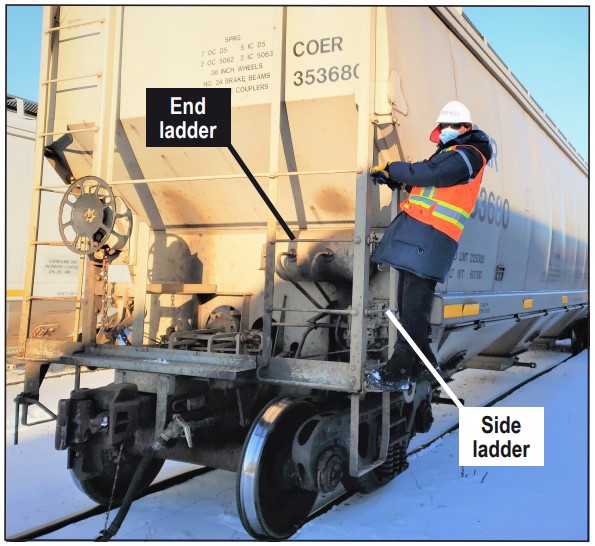Employee fatality
Canadian National Railway Company
Yard assignment YPC011-06
Mile 1.9, Montreal Subdivision
Montréal, Quebec
The Transportation Safety Board of Canada (TSB) investigated this occurrence for the purpose of advancing transportation safety. It is not the function of the Board to assign fault or determine civil or criminal liability. This report is not created for use in the context of legal, disciplinary or other proceedings. See Ownership and use of content. Masculine pronouns and position titles may be used to signify all genders to comply with the Canadian Transportation Accident Investigation and Safety Board Act (S.C. 1989, c. 3).
The occurrence
On 06 January 2021, the Canadian National Railway Company (CN) yard assignment YPC011-06 crew, composed of a conductor, a locomotive engineer (LE) and an assistant conductor, was conducting switching operations on a track near Pointe-Saint-Charles Yard in Montréal, Quebec, at Mile 1.9 of the Montreal Subdivision (Figure 1). Around 1225,Footnote 1 the train was reversing westbound on track PD06, the Port of Montreal spur, at approximately 10 mph, toward the yard. As the train was stopping while approaching signal 410RC, a sudden stretch on the couplers resulting from slack action occurred and spread to leading car COER 353680. The assistant conductor, who was holding on to the ladder at the end of this car, lost his grip, and fell on the track before the train stopped. The assistant conductor was fatally injured.
There was no derailment or collision.
The crew members were fit for work and qualified for their respective positions, and were familiar with the territory.
At the time of the occurrence, the train was composed of 2 locomotives and 21 empty covered hopper cars. It weighed about 908 tons and was about 1365 feet long.
The sky was clear and it was −1 °C. About 10 cm of snow covered the ground, and the rails were clear.
Information about Pointe-Saint-Charles Yard
Pointe-Saint-Charles Yard is located in the industrial area of the same name in the southeast part of the Island of Montreal. It is served by the Montreal Subdivision to the west and the Saint-Hyacinthe Subdivision to the east. It also contains many client industrial spurs, including track PD06, which leads to the Port of Montreal.
Track PD06 crosses Bridge Street at a public grade crossing.Footnote 2 Stop signs installed on both sides of the public grade crossing indicate to movements that they must come to a complete stop before entering the crossing in order to confirm that the warning devices have been activated.Footnote 3 The track then passes through a tunnel about 175 feet long under the tracks linking the Victoria Bridge to Central Station. Restricted clearance signs are located at both ends of the tunnelFootnote 4 (Figure 2). These signs remind train crews that riding moving equipment within the marked area is prohibitedFootnote 5 to reduce the risk of injury.
At the western end of track PD06, signal 410RC controls access to the Montreal Subdivision main track.
Site examination
On the occurrence site, the locomotives were stopped east of the tunnel entrance on track PD06; the leading car was about 400 feet from signal 410RC (Figure 3).
No obstructions were found on the track along the train’s route. The train’s brake pipe hoses were all connected.
Switching operations and procedures
The train had just coupled 21 empty cars and was reversing on track PD06 westbound toward Pointe-Saint-Charles Yard. The train was to take the Montreal Subdivision main track so it could change direction and take the cars onto a yard track. The LE and the conductor were on board locomotive CN 4807, while the assistant conductor was on a side ladder on the leading car to confirm that the track was clearFootnote 6 and communicate the distance remaining to the LE.Footnote 7
While the train was backing up, the conductor communicated with the rail traffic controller to obtain authorization and the required signals. The conductor made this communication using his personal cellphone, contrary to regulations.Footnote 8 Before proceeding across the Bridge Street public grade crossing, the train stopped for 20 seconds at the stop sign, in accordance with the rules. It then continued its route westbound on track PD06 and approached the restricted clearance tunnel.
The train did not stop before entering the tunnel to allow the assistant conductor to get off the car and walk through the tunnel, even though this was required by regulations. To ride the car through the tunnel and avoid being in the space between the side ladder of the car and the concrete wall, the assistant conductor repositioned himself on the end ladder of the leading car. This repositioning on the end ladder was contrary to CN’s instruction, which stipulates that personnel riding equipment must use the side ladder (Figure 4).Footnote 9 Employees are therefore able to get off the car more easily in case of emergency. This positioning also reduces the risk of serious injury should an accidental fall occur. The occurrence crew commonly followed this practice, without the knowledge of yard supervisors, to reduce the number of stops needed to get on or off equipmentFootnote 10 and to decrease their total time occupying the Bridge Street public grade crossing.
While the leading car was approaching the west end of track PD06, the assistant conductor indicated to the LE by radio that signal 410RC was displaying a medium to stop indication. He then indicated that there was a distance of 15 cars remaining before the train had to stop.Footnote 11 When there was a distance of 8 cars left, the assistant conductor once again communicated with the LE to inform him. Contrary to Rule 123.2 of the Canadian Rail Operating Rules (CROR),the LE did not repeat the remaining distance in these 2 communications.
The assistant conductor then indicated to the LE that there was a distance of 4 cars remaining before the signal. The LE then responded that he was stopping the train immediately before the locomotives entered the tunnel. He wanted to proceed this way to avoid the inconvenience of smoke accumulation in the restricted space and excessive noise caused by engine reverberation. According to information gathered during the investigation, at the same time that the LE was responding to the assistant conductor, he applied the independent brakeFootnote 12 and, about 15 seconds later, the train stopped. This rapid stop suddenly pulled on the train car couplers, the force of which spread to the leading car. The assistant conductor, who was still holding on to the ladder at the end of this car, lost his grip and fell on the track in front of the car before the train stopped. The assistant conductor was fatally injured.
Adaptations to rules and procedures
An adaptation is a practice that consists of intentionally deviating from rules, instructions, or procedures. These practices are generally used to carry out tasks more efficiently, but the safety implications are not necessarily fully considered. When an adaptation is performed with no negative consequences, it can be perpetuated and thereby become the norm, thus potentially reducing the safety margins that the rules, instructions, and procedures were intended to provide. Adaptations can also be perpetuated in the absence of adequate supervision. The adaptations noted in this investigation reflect the natural tendency to accept risks in order to avoid negative consequences, such as lost time and reduced productivity.Footnote 13
Re-enactment
A re-enactment of the occurrence the next day determined that after the independent brake was applied, there was a sudden stretch on the couplers, resulting in linear deceleration greater than 2gFootnote 14 in a very short period of time at the end of the leading car. This resulted in an unexpected jerk shortly before the train stopped.
Supervision
Train crews assigned to the Pointe-Saint-Charles area are supervised by CN supervisors based at Southwark Yard on the South Shore of Montréal. Each week, supervisors go to Pointe-Saint-Charles for ad hoc observation of the crews’ work.
In the weeks preceding the occurrence, members of the occurrence crew were audited by supervisors to assess the compliance of their work methods with the rules to follow when switching. No risky behaviours were identified at that time. In the year preceding the occurrence, there were no observations recorded in the assistant conductor’s file regarding CN General Operating Instruction 8.12.4, “Riding Equipment,” and the LE was not assessed on train handling rules.
CN’s current rulesFootnote 15 allow personal cellphones to be used for railway operations under exceptional circumstances, under the specific authority of a supervisor. The members of the occurrence crew used their personal cellphones in the course of their work to communicate with supervisors without being reprimanded for doing so. However, they also used their cellphones for personal purposes during their work shifts, and this use was not identified by local supervision during the audits that were conducted.
Other occurrences involving employees on duty
From January 2011 to January 2021, the TSB identified 92 occurrences in Canada where railway company employees were seriously or fatally injured as the result of incidents during their work shift. Of these 92 occurrences, 46 took place during switching, either in yards or while moving trains on various railway subdivisions in Canada. In these 46 occurrences, 33 employees were seriously injured and 13 were fatally injured.
Safety action taken
Following the occurrence, CN issued a circular to warn its employees about sudden stretch on the couplers resulting from slack action following excessive use of the independent brake. The circular reiterated the safety rules for riding equipment, the rules for communication between peers, and the importance of remaining vigilant to protect oneself against sudden movements and shocks caused by slack action. CN also issued an operating bulletin requiring movements on the Port of Montreal spur to be led by a locomotive or, when shoving equipment, by caboose CN 79834.Footnote 16
On 09 July 2021, TC sent CN a letter of non-compliance related to rules on employees riding equipment. The letter also raised concerns about non-conformities with CN special instructions, in particular General Operating Instruction 8.12.4 and CROR General Rule A(xii).
Safety message
Safety rules are generally developed while taking operating conditions into account to minimize the risks associated with railway operations. To ensure safe operations, it is vital that personnel systematically follow all the rules, and that railway companies enforce them uniformly and consistently at all times.
This report concludes the Transportation Safety Board of Canada’s investigation into this occurrence. The Board authorized the release of this report on . It was officially released on



